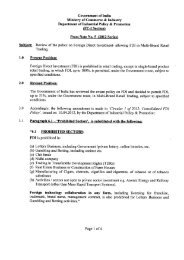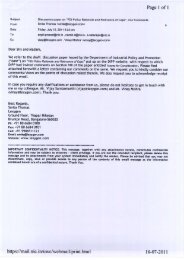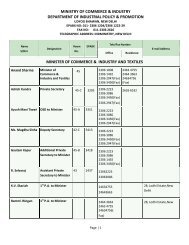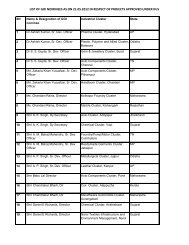fdi in india and its growth linkages - Department Of Industrial Policy ...
fdi in india and its growth linkages - Department Of Industrial Policy ...
fdi in india and its growth linkages - Department Of Industrial Policy ...
You also want an ePaper? Increase the reach of your titles
YUMPU automatically turns print PDFs into web optimized ePapers that Google loves.
Chapter 5: FDI: L<strong>in</strong>kages with the Economy<br />
5.1 The Concept<br />
One of the important ga<strong>in</strong>s expected from FDI <strong>in</strong>flows is that it would br<strong>in</strong>g <strong>in</strong> new skills <strong>and</strong> technologies <strong>and</strong> would<br />
generate productive l<strong>in</strong>kages with the economy. The concepts of backward <strong>and</strong> forward l<strong>in</strong>kages were first described by<br />
Hirschman (1958). Backward l<strong>in</strong>kages refer to the impact of <strong>in</strong>crease <strong>in</strong> the output of a downstream <strong>in</strong>dustry on <strong>its</strong><br />
dem<strong>and</strong> for <strong>in</strong>puts from upstream <strong>in</strong>dustries. For example, <strong>in</strong>creased production of passenger cars would boost dem<strong>and</strong><br />
for steel, rubber (tyres), auto components, etc. The impact of backward l<strong>in</strong>kages differs across upstream <strong>in</strong>dustries s<strong>in</strong>ce<br />
the downstream <strong>in</strong>dustry does not buy <strong>in</strong>puts equally from all <strong>in</strong>dustries. Forward l<strong>in</strong>kages refer to <strong>in</strong>creased production<br />
of an upstream <strong>in</strong>dustry on requirements of downstream <strong>in</strong>dustries. Thus, <strong>in</strong>creased production of petroleum products<br />
would make <strong>its</strong> availability easy for downstream <strong>in</strong>dustries that use petroleum products as <strong>in</strong>puts. The impact of forward<br />
l<strong>in</strong>kages is not uniform across downstream <strong>in</strong>dustries s<strong>in</strong>ce their requirements of <strong>in</strong>put from an upstream <strong>in</strong>dustry are<br />
not uniform. An <strong>in</strong>dustry may be strong <strong>in</strong> <strong>its</strong> backward l<strong>in</strong>kage effects, forward l<strong>in</strong>kage effects, both of these or none<br />
of these.<br />
FDI <strong>in</strong>flows have various types of impact on a domestic economy. One of the most important effects relates to “vertical<br />
l<strong>in</strong>kages”, i.e., the impact of FDI com<strong>in</strong>g to a particular sector on <strong>in</strong>ter-<strong>in</strong>dustry transactions. Vertical spill-overs can be<br />
analysed through comput<strong>in</strong>g backward <strong>and</strong> forward l<strong>in</strong>kages of sectors where the FDI is com<strong>in</strong>g <strong>in</strong>.<br />
We concord four-digit DIPP sectors <strong>in</strong>to 130 Input Output Transaction Matrix (IOTM) sectors to check the type of<br />
sectors <strong>in</strong>to which a major share of FDI has been received.<br />
5.2 Computation of L<strong>in</strong>kages<br />
We used the Hirschman-Rasmussen Index method to compute backward <strong>and</strong> forward l<strong>in</strong>kages from India’s IOTM<br />
(2003-04). Backward l<strong>in</strong>kages refer to the dem<strong>and</strong>-pull concept <strong>and</strong> forward l<strong>in</strong>kages to the supply-push concept<br />
developed by Rasmussen (1958) <strong>and</strong> Hirschman (1958). 1<br />
We follow the computations of backward <strong>and</strong> forward l<strong>in</strong>kages based on the st<strong>and</strong>ard <strong>in</strong>put-output model of an<br />
economy:<br />
AX + F = X<br />
<strong>and</strong><br />
X = (I – A) -1 F or X = BF<br />
where X is the n x 1 vector of total output requirement of the economy with n sectors of production; A is the n x n matrix<br />
of <strong>in</strong>put coefficients; F is the n x 1 vector of f<strong>in</strong>al dem<strong>and</strong>; <strong>and</strong> B is the n x n matrix of (I – A) -1<br />
. aij are n x n elements<br />
of <strong>in</strong>put coefficients of A-matrix of IOTM <strong>and</strong> bij are n x n elements of (I – A) -1 matrix.<br />
1. Refer to CSIRO (2007) for details on computation of backward <strong>and</strong> forward l<strong>in</strong>kages.<br />
49












